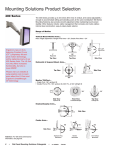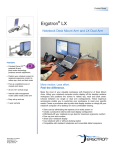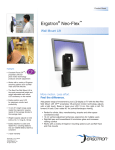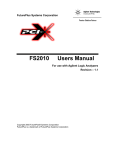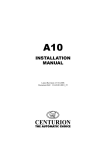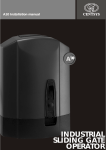Download Ellison E2201-18 User guide
Transcript
18 in. EVOLUTION Easy-Push Reel Mower with Adjustable Grass Management System Model Number: E2201-18 User Guide Save for future reference 1 Para ver la versión en español, dé vuelta al guía de usuario 1 18 in. EVOLUTION Easy-Push Reel Mower with Adjustable Grass Management System Model Number: E2201-18 Fill in the following information and save: Date of Purchase: _______________________ Retailer: _______________________________ If you need assistance or have questions, don’t return to the store. Call our customer service at 1-800-918-8290 Visit us at www.ellison-tools.com FOUR YEAR LIMITED WARRANTY For four (4) years starting after the date of purchase, ELLISON warrants to the original purchaser that its Lawn Mower products are free from serious defects in materials and workmanship appearing under normal use. This warranty does not cover damage to the Lawn Mower caused by abuse, acts of God, failure to follow product instructions, mishandling or unauthorized repair by either the purchaser or an unauthorized third party. THIS WARRANTY IS IN LIEU OF ALL OTHER EXPRESS WARRANTIES; AND ANY IMPLIED WARRANTIES, INCLUDING BUT NOT LIMITED TO ANY IMPLIED WARRANTY OF MERCHANTABILITY OR FITNESS FOR PARTICULAR PURPOSE, ARE LIMITED TO THE DURATION OF THIS WARRANTY. IN NO EVENT WILL ELLISON BE LIABLE FOR ANY INCIDENTAL OR CONSEQUENTIAL DAMAGES. Some states do not allow limitations on how long an implied warranty lasts and/or the exclusion or limitation of incidental or consequential damages, so the above limitation and/or the above exclusion may not apply to you. This warranty gives you specific legal rights, and you may also have other rights which vary from state to state. As its sole responsibility and your sole remedy for any warranted defect, ELLISON will replace any defective part of the Lawn Mower, containing a warranted defect, free of charge, with proof of purchase and notification within a reasonable period of time (but no longer than 6 months) following the discovery of such defect. Any non-residential use of this product voids all warranty. For warranty service, email [email protected] or call 1-800-918-8290. 2 2 Warranty …………………………………………………............................ 2 Getting Started…………………………………………………….…….…… 3 Safety Information..…………………………….…………………….……… 4 Product Features…….……………………...…………………….….……… 5 Main Operating Parts….……………………………………………..……… 6 Handle Assembly………….….…...………………………..….……..…….. 7 Attaching the Handle……………….…….……………………….………… 8 Attaching the Grass Bag………………....……………………….………… 9 Grass Management System.…….………………………..……..………… 10 One-Touch Height Adjust…...…………………………….….….………… 11 Checking Cutting Blades………………….…………………….…............ 12 Adjusting the Blade…………………………………………...................... 13 Checking Cutting Performance………………..…………………………… 14 Tips for Mowing Correctly…..……….….…...…………….………..….….. 15 Care and Maintenance…………………..….………………..…................ 16 Troubleshooting……………...………………………………...….……....... 18 3 Getting Started: Getting Started Contents 1. Read User Guide Please carefully read the entire user guide and fully understand the safety information before assembling or using the mower. Use this guide to familiarize yourself with the mower, how to adjust it, and correct usage for best results. 2. Tool-less assembly Turn to page 7 and follow instructions for assembly of the Handle and attachment of the Grass Bag. 3. Check cutting blade performance Check cutting performance by mowing your lawn. If you have any issues, turn to page 12 and follow instructions to confirm proper setting of the cutting blades 3 Safety Information ! WARNING Safety Information Do not use mower if you are in poor health. Use the mower only for its intended purpose. Do not use mower in areas other than grass. Check mower before each use. Do not operate with missing, worn, or damaged parts. Inspect your lawn for any debris or foreign objects (such as stones, twigs, pieces of wood, and wires) and remove them before mowing. Solid objects that contact the cutting blades could be thrown out uncontrollably. Always wear safety glasses, gloves, and closed-toe shoes when operating and maintaining your mower. Do not operate the mower while barefoot or wearing sandals or flip flops. Never place hands, fingers, or feet in the rotating blades. When the blades are spinning, they will cut. Please carefully read the entire user guide and fully understand the safety information before assembling or using the mower. Use this guide to familiarize yourself with the mower, how to adjust it, and correct usage for best results. Never mow when the grass is wet enough to be slippery and unsafe. Use safe lifting practices when moving your mower. Do not allow children under 12 years to use mower. Do not operate around children, other people, or pets. If you need assistance or have questions, Call our customer service at 1-800-918-8290 Visit us at www.ellison-tools.com Walk slowly, never run while using your mower. Always be sure of your footing when using the reel mower, especially on damp grass or on uneven surfaces. Keep packaging material such as plastic bags out of the reach of children! Protect the mower against weather conditions (humidity, frost). Make sure your mower is in safe operating condition by following the tips outlined in this user guide. Do not use this mower if it becomes damaged. Have it repaired first. Call 1-800-918-8290 or visit www.ellison-tools.com for troubleshooting, frequently asked questions, and for finding a qualified repair service. 4 4 Easy Push Cutting System Grass Management System 1) Much easier to use 2) Maintains higher blade speeds with less effort 3) Blades stay sharp - no seasonal sharpening required The oversized Grass Bag plus the Grass Deflector (Patents Pending) allow for the greatest control over grass clippings of any reel mower during both collecting and mulching modes. One Touch Height Adjustment Fixed Handle Height Adjusts cutting height with one quick and easy motion and keeps hands away from the blades Keeps the handle at a comfortable ergonomic height, independent of cutting height adjustment Greater Height Range Pivot-Turn Design Best-in-class cutting height adjustment from 1-in to 4-in for a better cut during the wet season when grass gets long quickly Lets users control the mower like a power mower with a push-down-andpivot movement for easier turns Product Features Product Features Faster Blade Speed Through re-designed gearing for better cutting in all conditions Tool-less Assembly 5 5 Main Components Main Components Handle Grip Height Adjustment Knob (1-in to 4-in cut height adjustment) Handle Cover Handle Knobs (2) Left Side Cover Handle Frame Grass Bag Mount Right Grass Deflector Grass Bag Handle Grass Bag Cutting Reel (with 5 helical cutting blades) Rear wheels (2) Stationary Blade Right Side Cover Front wheels (2) 6 Top Cover Middle Brace Grass Bag Mount Left Actual product may vary 6 ① There are no tools required for assembly of the handle. ② Note that the Upper Handle (A) is already factory pre-assembled with the Center Handle (B), the Handle Cover (C), and the Handle Bolts (D). ③ Lay out the parts as shown below. Note the Lower Handle parts (E) are symmetric, and there is no right or left version. ④ In order to install the Lower Handle parts (E) into the Center Handle (B), you must first remove the Handle Cover (C) by flexing the plastic Snap Arms (F) outward and pulling the Handle Cover (C) upward. (See inset image) ⑤ Next, remove the Lower Handle Bolt (D) by loosening the Handle Knob (G). Be sure to keep the Handle Washer (H). ⑥ Insert the free ends of the Lower Handles (E) into the Center Handle (B), making sure that they are resting flat on the ground. Align the holes in the position that is most comfortable for usage. Note: There are multiple positions for handle height. If uncertain, start in the lowest handle height position and adjust to a height that is the most comfortable for you. Both bolts locations can adjust height of handle. ⑦ Insert the Lower Handle Bolt (D) through the Center Handle (B) and through the Lower Handles (E). ⑧ Once the threaded portion of the Lower Handle Bolt (D) is sticking through the tubing fully, assemble the Handle Washer (G) and then screw on the Handle Knob (F). ⑨ Using the knob, tighten the bolt until it is snug. Do not over tighten or permanent damage to the handle may result. ⑩ Snap the Handle Cover (C) over the Center Handle (B). Handle Cover (C) Handle Assembly Handle Assembly (first time use) Snap Arms (F) Lower Handle Bolt (D) Lower Handles (E) Center Handle (B) Upper Handle (A) Handle Washer (H) Handle Knob (G) 7 7 Attaching the Handle Attaching the Handle ① Once the handle components are fully assembled, the next step is to attach the handle to the mower. Do not install the Grass Bag yet. ② Note the attachment pegs on the inside facing surfaces of the main mower body. Shown in the inset as (I) ③ While gripping the handle by the Lower Handle tubes shown as position (J) and (K), squeeze these two areas inward and hook the holes in the ends of the tubes onto the attachment pegs from the main mower body (I). ④ Stop squeezing inward, and allow the handle assembly to relax. ⑤ If the handle is rotated upward fully, it is in its storage position. When rotated downward, it will stop at its usage position. ⑥ Test the height of the usage position. There are multiple height positions for the Handle. See page 7 for adjustment instructions. ⑦ To remove the handle, squeeze areas (J) and (K) inward and unhook from the attachment pegs (I). (J) Attachment Peg (I) (K) 8 8 Once the handle is attached to the mower, rotate it fully upward to its storage position. Position the Grass Bag as shown in the figure below. Note the attachment slots on the mower inside of the rear wheels on both ends (L). The attachment rods on the Grass Bag are also on both ends. The right side is shown as (M). ⑤ Insert the Grass Bag attachment rods into the attachment slots on the mower. ⑥ Rotate the Handle downward to its usage position and it is ready to use. ① ② ③ ④ Handle in Storage Position Attaching the Grass Bag Attaching the Grass Bag (L) (L) (M) (L) 9 9 Grass Management System Using the Grass Management System ① The Grass Management System consists of the Grass Deflector (Patents Pending), an oversized Grass Bag, and our One-Touch Height Adjustment from 1 to 4 inches. These provide the greatest control over grass clippings of any reel mower. ② There are 2 modes of usage: Grass Collecting and Mulching. During the dry parts of the season, mulching is recommended to help maintain moisture in your lawn. During the peak parts of your season when grass is growing the fastest, multiple grass collecting passes are recommended. ③ When collecting the grass clippings, attach the Grass Bag and position the Grass Deflector upward so the grass clippings are directed toward the back of the Grass Bag. ④ Depending on the height setting for the mower (from 1 to 4 inches), the Grass Deflector’s position will need to change slightly to always be directing the grass clippings toward the back of the Grass Bag. ⑤ The Grass Deflector also prevents the grass clippings from “spraying” upward to the sides of the mower and back at the user. ⑥ To redirect the Grass Deflector (only when the cutting reel is not rotating), pull downward or upward holding onto the middle grip area to change its position. ⑦ When mulching, remove the Grass Bag, and set the Grass Deflector to its lowest position. ⑧ With the Grass Deflector set at its lowest position, the grass clippings will be directed back down to the lawn rather than “spraying” upward like most reel mowers. ⑨ When mulching, it is recommended to only cut about 1 inch or less of the grass height in order to receive the maximum mulching benefit from the smaller grass clippings which will help your lawn maintain moisture and help support a healthy root system acting as fertilizer for the lawn. Grass Collecting Mode Position the Grass Deflector as needed to direct grass toward the back of the Grass Bag Grass Mulching Mode Position the Grass Deflector fully down to direct grass back down to the lawn Note: Leaving behind excess grass clippings that are too long can stress the lawn leaving it susceptible to weeds, disease, and poor appearance. See additional tips for mowing on page 15. 10 10 ① Your mower has a One-Touch Height Adjustment for varying your grass cut height from 1 to 4 inches. ② To adjust the cutting height, face the mower from its right side and hold onto the Lower Handle bar with your left hand. With your right hand, grip the One-Touch Height Adjustment Knob. (See illustration on the right) ③ Pull the Height Adjustment Knob toward you to take it out of its current position and then slide it to your left or right to change its position. ④ Note the markings of 1 and 4 (inches) and the 5 positions in between. These 7 positions correspond to the height of grass after cutting (cut height). ⑤ Choose a cut height based on the current height of your grass and your lawn preference. Cut off no more than 1/3 of the current height of the grass with each mowing. ⑥ The One-Touch Height Adjustment system has a spring-assist which makes it easier to raise the mower to a taller cut height. ⑦ If your grass is tall, always start at the 4 inch position first and then lower the cut height to the desired setting. ⑧ For best results, do not let grass get taller than 6 inches. The mower will not cut well if the grass is over 6 inches tall. Lower Handle bar grip position (left hand) Height Adjustment Knob (right hand) One-Touch Height Adjustment One-Touch Height Adjustment 4 inch cut height Note the markings 1 and 4 (inches) and the 5 positions in between 11 Face right side of mower to adjust height 11 Checking Cutting Blades Checking Cutting Blades Your EVOLUTION Reel Mower has been designed to cut grass without the blades actually touching. This makes it easier to use, maintains higher blades speeds with minimal effort, and the blades do not require seasonal sharpening. There should always be a very small gap between the helical cutting blades and the stationary blade. It is possible for slippage to occur during shipping, handling, or usage. It is important to check the cutting performance before first use, yearly and whenever an issue is found. Follow the steps below to check current cutting performance and, if needed, to adjust the cutting blades for optimal performance. If you need assistance or have questions, Call our customer service at 1-800-918-8290 Visit us at www.ellison-tools.com ATTENTION: If the spinning cutting blades are making contact with the stationary blade, forcing them to rotate may cause damage or dulling of the blades. ① When working with the cutting blades, it is important that you follow all of the safety guidelines on page 4. Cutting Reel (with 5 helical cutting blades) WARNING: The mower blades are sharp! Wear gloves for this procedure, and keep fingers away from the interface between the helical cutting blades and stationary blade. ② If the handle or grass bag is attached, start by removing them. ③ Lower the mower to its lowest cutting height setting of 1 inch. ④ Place the mower up-side-down on a table, workbench, or other firm, level surface. ⑤ Face the front of the mower to see its helical cutting blades and stationary blade. The large wheels should be closest to you. ⑥ Check to see if the cutting blades make contact by slowly rotating each helical cutting blade away from you (toward the stationary blade) checking one at a time for a full rotation or two. Do not grip the blade ends, as they are extremely sharp. ⑦ If the blades are not scraping, proceed to checking cutting performance on page 14. ⑧ If at any point you hear scraping or feel resistance from the blades, stop and proceed to Adjusting the Blades on page 13. 12 Stationary Blade Face the front of mower to check and adjust the blades Height adjustment set to 1 inch position 12 If the blades are touching: (from test on page 12) If the helical cutting blades are touching the stationary blade, first check for any damage or dents on both the helical cutting blades and the stationary blade. If any dents are found, turn to page 16 for instructions on repairing dents. If there is no visible damage, then begin with step 1 below to loosen the Adjustment Bolts to separate the blades. Adjustment bolt 1/24 of a turn If the blades are not touching: (from test on page 14) If the helical cutting blades are not touching the stationary blade anywhere, you can tighten the Adjustment Bolts to adjust the gap between them for optimal cutting performance. Begin with step 1 below. WARNING: The mower blades are sharp! Wear gloves for this procedure, and keep fingers away from the interface between the helical cutting blades and stationary blade. Adjusting the Blades Adjusting the Blades Adjust very slightly Stationary Blade Helical Cutting Blade ① Ensure mower is in up-side-down position as described on page 12. ② There are two adjustment bolts on the sides of the mower that control the spacing between the helical cutting blades and the stationary blade. See figure on the right. They can be tightened or loosened using the 5mm hex key (allen wrench) included with your mower. ③ Adjusting the Adjustment Bolts is a very sensitive procedure, 1/24th of a turn is considered a major adjustment. Start adjusting very slightly on the appropriate side. Tightening the bolt (clockwise) moves the blades closer together and loosening (counter-clockwise) separates the blades further apart. ② If the blades are making contact, loosen the adjustment bolts while rotating the helical cutting blades stopping as soon as the blades lose contact. Go to the Checking Cutting Performance - Paper Test on page 14. ③ When properly adjusted the helical cutting blades and the stationary blade should be just short of making contact Adjustment Bolts Face the front of mower to adjust the blades 13 Height adjustment set to 1 inch position 13 Checking Cutting Performance 14 Checking Cutting Performance – Paper Test If the helical cutting blades are not touching the stationary blade, you can now check if the blades cut properly. You will need to check both the left side and the right side of the mower. WARNING: The mower blades are sharp! Wear gloves for this procedure, and keep fingers away from the interface between the helical cutting blades and stationary blade. ① You will need several 1 inch wide strips of standard printer paper about 8.5 inches long. ② Starting on your left side, feed a 1 inch wide strip of paper vertically between the stationary blade and the helical cutting blades as shown in the figure on the right. About a half of an inch of the paper should be below the stationary blade. ③ Rotate the helical cutting blades away from you (toward the stationary blade). ④ If the blades are properly adjusted, the paper should be cut as the helical cutting blades pass across the stationary blade. Test on several of the helical cutting blades as you rotate the cutting reel. If the paper is cut on the left side, move to the right side and repeat this test. If the paper is cut on the right side, the system is properly adjusted. Blade adjustment is complete, and the mower is ready to cut grass. ⑤ If the paper is not cut on either the left side or the right side, then the gap between the blades is too large. For reference, see Adjusting the Blades on page 13. ⑥ Tightening the Adjustment Bolts is a very sensitive procedure, 1/24th of a turn is considered a major adjustment. Start tightening very slightly and repeat the paper test above. ⑦ Keep tightening in very small increments until the paper begins to cut. NOTE: Be sure to use a new portion of the paper for each test. ⑧ If you tighten to the point at which the blades touch, you have tightened too much. Loosen the Adjustment Bolts in the same very small increments and rotate the blades until there is no contact. ⑨ If the paper cuts on both the left and right sides of the blade, the system is properly adjusted, and the mower is ready to cut grass. If you need assistance or have questions, Call our customer service at 1-800-918-8290 Visit us at www.ellison-tools.com ATTENTION: If you do not position the cutting blades correctly, the result will be poor cutting performance and uncut blades of grass will be left behind. Adjustment Bolts Stationary Blade Face the front of mower to check cutting performance Cutting Reel (with 5 helical cutting blades) Height adjustment set to 1 inch position 14 Use the following tips to ensure the proper function of your EVOLUTION Reel Mower for many years. ① Clear lawn of debris and foreign objects prior to each use. This prevents the primary causes of damage to the cutting blades. ② If you hit something while mowing, always stop to inspect the blades for a jam or damage. If a blade appears damaged, do not continue mowing since forcing the cutting blade to rotate can cause more damage. Instead, move the mower to an appropriate work area and follow the instructions in the Care and Maintenance section on page 16. ③ In order to maintain a healthy lawn, be sure to mow weekly. If the grass gets too high, be sure to set the mower to its 4 inch position and cut off a smaller amount of grass first before adjusting the height to the lower height setting. ⑥ It is best to mow when the grass is dry. Cutting wet grass creates clumps, which can accumulate on the lawn and damage it. If it is necessary to mow when the grass is wet, be sure to use the Grass Bag and pay extra care to safe mowing practices. ⑦ When operating the mower on a flat, dry lawn, it is best to walk briskly to maximize the cutting performance since the cutting blades will spin faster. Note: DO NOT RUN AND MOW. This is a safety hazard. Tips for Mowing Correctly Tips for Mowing Correctly If you need assistance or have questions, Call our customer service at 1-800-918-8290 Visit us at www.ellison-tools.com ④ When mowing high grass, be sure to use the Grass Management System consisting of the oversized Grass Bag and Grass Deflector (Patents Pending) to contain the grass clippings. Leaving behind excess grass clippings that are too long can stress the lawn leaving it susceptible to weeds, disease, and poor appearance. ⑤ When mulching is desired, remove the Grass Bag and adjust the position of the Grass Deflector to its bottom position to direct the grass clippings back down to the lawn. Be sure to cut 1 inch or less off the grass height in order to receive the maximum mulching benefit. The smaller grass clippings will help your lawn maintain moisture and help support a healthy root system, acting as fertilizer for the lawn. 15 15 Care and Mainenance Care and Mainenance Minimal care is needed to maintain your EVOLUTION mower. However, take these steps to ensure optimal mower performance. Avoid damage to the mower or cutting blades. Keep your mowing area free from any debris or foreign objects such as stones, twigs, pieces of wood, and wires. Solid objects can both damage the cutting blades and be a safety hazard to the user, as they could be thrown uncontrollably. Be careful to never hit stationary objects with your mower since it can damage the components. Sudden impacts during use or storage can cause irreparable performance issues. Keep your mower dry. Your mower will perform better and longer if it is kept dry. The precision ground helical blades of the cutting reel and the stationary blade are the most vulnerable to rust, as well as the bearings that hold the cutting reel. If your mower does get wet, dry with a cloth first and spray the cutting reel and stationary blade with a rust preventer. Then, spray the bearings on the sides of the cutting reel with a lubricant to ensure that they spin freely. The cutting blades should remain sharp for years due to the non-contact Cutting Reel technology, provided the mower and its components are maintained properly and not misused. Protect your mower against weather conditions. Do not store your mower outside since the humidity and frost can cause performance issues. At least once a season, perform a thorough cleaning followed by an application of a lubrication and rust preventer. The shaft bearings that hold the cutting reel periodically require lubrication to ensure that they spin freely. See image below. Rust preventer is needed on the ground edges of the cutting reel and the stationary blade to ensure that they do not rust over time due to humidity and wet grass clippings. It is recommended that this seasonal maintenance be done at least once a season and prior to winter storage to maintain peak performance. Keep your mower clean. Always keep your mower clean and remove grass deposits so it will last longer and perform better. Residual grass clippings and dirt can be easily removed immediately after mowing using a brush and a cloth. Pay particular attention to cleaning the area on the sides of the cutting reel to prevent the dirt and moisture from the grass clippings to clog the cutting reel’s shaft bearings. If grass clippings and dirt stick to the cutting blades, it can reduce cutting performance. ATTENTION: Do not use solvents such as mineral spirits or kerosene to clean your mower since they will damage the plastic and rubber parts! ATTENTION: Do not use a garden hose to wash your mower. Storing the mower wet will allow rust to form and performance will be greatly reduced. 16 Cutting Reel Shaft Bearing (left side) 16 If the cutting blades start to touch the stationary blade, it will produce a scraping sound or it will not rotate freely at all. In this case, stop immediately and prepare to check for damage to the blades. Before checking for blade damage, place the mower on a firm, level surface. WARNING: The mower blades are sharp! Wear gloves for this procedure, and keep fingers away from the interface between the helical cutting blades and stationary blade. ATTENTION: If the cutting reel is difficult to turn, do not force it to turn as it may have begun contacting the stationary blade. This can cause even more damage. Begin examining each of the helical cutting blades on the cutting reel. Slowly try to turn the cutting reel and check if a point of interference is found. If there is interference, look to see if there is a dent on either the helical cutting blades or on the stationary blade. Only small dents can be repaired. If there is no apparent damage to any of the five helical cutting blades, then the stationary blade may have shifted too close or too far from the stationary blade. Follow the step by step instructions on page 13 for adjusting the blades. 17 Repairing a small dent is possible. If minor damage such as a dent is found on one of the five helical cutting blades, it is possible to file down using a steel file. To remove the dent, only file away enough of the raised material to allow the cutting reel to spin without making contact with the stationary blade. Be sure to file with long strokes, perpendicular to the cutting edge itself. Try to avoid filing material off the sharp edge of the blade. Take your time with this procedure since your safety is most important. WARNING: The mower blades are sharp! Wear gloves for this procedure, and keep fingers away from the interface between the helical cutting blades and stationary blade. Care and Maintenance Inspect your blades at least once a season and anytime your mower hits a solid or stationary object. The cutting blades can become damaged or the stationary blade can become out of alignment if the mower strikes something hard. The following are common scenarios, as a result of hitting a stationary object: 1. The cutting reel will begin to touch the stationary blade making it difficult or impossible to push, or, 2. the gap between the two blades will become too large resulting in reduced cutting performance. ATTENTION: Do not use a power tool to repair the helical cutting blades or the stationary blade. It is very dangerous and can cause too much material to be removed which will result in lower performance. Once the dent has been removed, examine again to see if there is any contact between the helical cutting blades and the stationary blade. If there is contact, repeat the above filing process, or call the Help Line at 1-800918-8290 to find an authorized repair center near you. Sharpening the blades. The blades should not need sharpening for many years of normal usage. If you think the blades need to be sharpened, seek an authorized professional. Sharpening with an abrasive compound will not work and could cause damage. Always seek an authorized professional to sharpen the blades. Special sharpening equipment is needed to successfully sharpen the helical cutting blades. ATTENTION: Do not attempt to sharpen either the helical cutting blades or the stationary blade by yourself! Always seek an authorized professional that has the proper equipment and training for sharpening this type of blade. Call the Help Line at 1-800-9188290 to find an authorized repair center near you. 17 Troubleshooting Troubleshooting Your EVOLUTION Reel Mower with Grass Management System is designed to operate right out of the box with only the quick tool-less assembly of the Handle needed. If you experience any issues using the mower, please read the information below to help you diagnose your problem and find a solution. Problem: The mower is hard to push. Are you trying to cut too much grass? • Check the height setting for the mower. Be sure that you are not trying to cut more than 1/3 off the height of the grass. The mower may become difficult to push if the height setting is too low. • Try to adjust the height setting higher and closer to the 4 inch setting. Is the height of the handle comfortable for pushing? • The handle has multiple height positions that do not change as the grass cutting height is adjusted. If you need to adjust the handle height, see page 7. Are the cutting reel or blades clogged with grass, dirt, or debris? • Check to see if anything is causing a jam for the cutting reel, in particular look on the cutting blades and on the sides of the cutting reel. If debris is found, clean with a brush. Do not stick your hand inside the cutting blades! Are the cutting blades making contact with the stationary blade? If so, this could be caused by two reasons: • The stationary blade has shifted during shipping, handling, or operation. If the cutting gap has become too small or non-existent, the blades will touch, but they should not. To check if the cutting gap is properly set, see Adjusting the Blades on page 13. • The blades could be making contact due to a dent or other damage to the blades. See page 17 for inspecting and repairing a dent in the blades. 18 If you need assistance or have questions, don’t return to the store. Call our customer service at 1-800-918-8290 Visit us at www.ellison-tools.com Problem: The mower is leaving behind uncut grass Is your grass long or are tall weeds present? • Check the height setting for the mower. Be sure that you are not trying to cut more than 1/3 off the height of the grass. The mower will not be able to cut grass over 6 inches long or if tall weeds are present. • Try to adjust the height setting higher and closer to the 4 inch setting. • Pull any tall weeds that are present, and also try to mow from a different direction to see if that helps. Is the blade gap adjusted properly? • The gap between the cutting blades and the stationary blade can shift during shipping, handling, or operation and become larger than it should be. If the gap is too large, the cutting performance will be reduced. • To check if the cutting gap is set properly, see Adjusting the Blades on page 13. 18 WARNING Safety Information Do not use mower if you are in poor health. • Check to see if anything is causing a jam for the cutting reel, in particular look on the cutting blades and on the sides of the cutting reel. If something is found, clean with a brush. Do not stick your hand inside the cutting blades! Do not use mower in areas other than grass. Are the cutting blades making slight contact with the stationary blade? If so, this could be caused by two reasons: • The stationary blade has shifted during shipping, handling, or operation. If the cutting gap has become too small or non-existent, the blades may just touch in some areas, but they should not. To check if the cutting gap is properly set, see Adjusting the Blades on page 13. • The blades could be making contact is due to a dent or other damage to the blades. See page 16 for inspecting and repairing a dent in the blades. Use the mower only for its intended purpose. Check mower before each use. Do not operate with missing, worn, or damaged parts. Troubleshooting ! Problem: The mower is making a scraping or “tick” noise Are the cutting reel or blades clogged with grass, dirt, or debris? Inspect your lawn for any debris or foreign objects (such as stones, twigs, pieces of wood, and wires) and remove them before mowing. Solid objects that contact the cutting blades could be thrown out uncontrollably. Always wear safety glasses, gloves, and closed-toe shoes when operating and maintaining your mower. Do not operate the mower while barefoot or wearing sandals or flip flops. Never place hands, fingers, or feet in the rotating blades. When the blades are spinning, they will cut. Never mow when the grass is wet enough to be slippery and unsafe. Use safe lifting practices when moving your mower. Do not allow children under 12 years to use mower. Do not operate around children, other people, or pets. Walk slowly, never run while using your mower. Always be sure of your footing when using the reel mower, especially on damp grass or on uneven surfaces. Keep packaging material such as plastic bags out of the reach of children! Protect the mower against weather conditions (humidity, frost). Make sure your mower is in safe operating condition by following the tips outlined in this user guide. Do not use this mower if it becomes damaged. Have it repaired first. Call 1-800-918-8290 or visit www.ellison-tools.com for troubleshooting, frequently asked questions, and for finding a qualified repair service. 19 19 159 N. Racine Ave. 3E Chicago, IL 60607 (800) 918-8290 www.ellison-tools.com 20 20




















